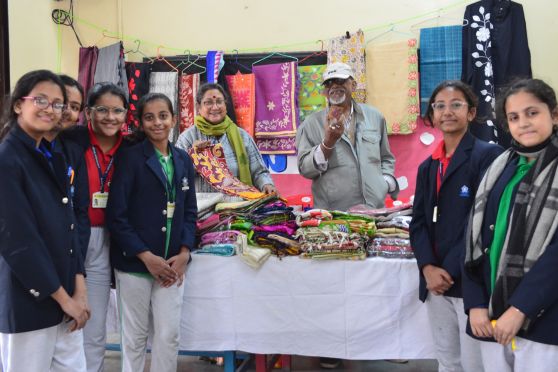Lakshmipat Singhania Academy Hosts Taana Baana: A Curation of India's Rich Heritage


On the 16th & 17th of January, Lakshmipat Singhania hosted the textile exhibition- Taana Baana - a curation of India's rich heritage passed down from generations to reach the hands that created the displayed craft.
India's artistic heritage is a culmination of the indigenous communities that practised different forms of art that developed into characteristic archetypes of the handicrafts from each state. A testament to this development is reflected in India's quintessential attire, the saree. Sarees weaved by the styles prevalent in the different provinces of India were displayed. From Bihar, Andhra Pradesh and Gujarat to the Bangladeshi influence over West Bengal’s drapery was presented by way of the colourful sarees, shawls and dress material.
The exhibition was put up as a visual treat that reveals itself to the viewer as one walks into the school grounds. The first stall was set up by Chaiti Datta, a skilled local artisan, who welcomed everyone with the delightful sight of handcrafted jute bags and tote bags.
Beautiful coasters crafted with intricacy and precision, and double-sided painted spatulas were presented. Unbreakable plates made with paper, gum, atta and cornflour that were as functional as they were artistic was a testament to the craftsmen's inventiveness.

A staple of student life and the one stationery that adorns the desk corners of every office- pen stands, which this time were made with jute and ceramic, two contrasting but equally interesting materials. As integral as chai is to the great Indian cuisine, the carefully carved teapots that were often the inheritance of young daughters from their mothers is a culinary equipment that has created a space for itself as not only an essential of the kitchen but also the vessel that holds artistic heritage in its carvings. The teapots that were presented held a similar cultural value and beauty, emanating from its spout and warming the atmosphere much like the tea it held inside. LSA’s Director Meena Kak said, “Textiles are an important component of economies and social relationships. We encourage the students to understand the hard work of the artisans and at the same time value the rich heritage of our country.”
The exhibition had a little something that catered to everyone’s tastes, handcrafted bookmarks for the avid readers and water bottles for the persevering students on the run. A feast for the eyes that also served a purpose beyond its captivating display.
A part of one’s beliefs, semi-precious stones and crystals that caught the light of the winter sun in bewitching ways were carefully obtained, tumbled and cleaned for presentation by the skillful artisans. Apart from this, handcrafted jewellery including pendants, earrings, rings and bracelets adorned the stalls and were sold in the blink of an eye. To complete the embellishments were handwoven shawls and stoles. Replicas and showpieces made out of silver rounded off the exposition with its home decor appeal.
India's uniqueness lies in its inimitable coalescence of ancestral traditions and modernity. Every craftsman, every vendor at this exhibition was a purveyor of India's artistic heritage. It was a wonderful opportunity for parents and students alike to witness the marvel of India's handicraft and cottage industries in the premises of Lakshmipat Singhania Academy.